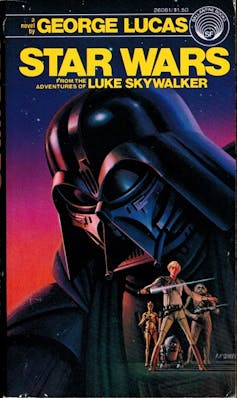Entertainment
The woman who revolutionized the fantasy genre is finally getting her due

Dennis Wilson Wise, University of Arizona
Think of your favorite fantasy or science fiction novel. You’ll know the author and title, of course. But can you think of its editor or publisher?
In publishing, the people who work behind the scenes rarely get their due. But on Oct. 1, 2024, at least, one industry pioneer got the limelight. On that day, PBS aired “Judy-Lynn del Rey: The Galaxy Gal,” the first episode of its new documentary series “Renegades,” which highlights little-known historical figures with disabilities.
A woman with dwarfism, Judy-Lynn del Rey was best known for founding Del Rey Books, a science fiction and fantasy imprint that turned fantasy in particular into a major publishing category.
As a scholar of fantasy literature, I had the good fortune to serve as research consultant for the PBS project. Due to time constraints, however, the episode could tell only half of del Rey’s story, passing over how she affected science fiction and fantasy themselves.
Judy-Lynn del Rey, you see, had very clear notions on what kind of stories people wanted to buy. For some critics, she also committed the unforgivable sin of being right.
The Mama of ‘Star Wars’
Over the course of her career, del Rey earned a reputation as a superstar editor among her authors. Arthur C. Clarke, who co-wrote the screenplay for “2001: A Space Odyssey,” called her the “most brilliant editor I ever encountered,” and Philip K. Dick said she was the “greatest editor since Maxwell Perkins,” the legendary editor of Ernest Hemingway and F. Scott Fitzgerald.
She got her start, though, working as an editorial assistant – in truth, a “gofer” – for the most lauded science fiction magazine of the 1960s, Galaxy. There she learned the basics of publishing and rose rapidly through the editorial ranks until Ballantine Books lured her away in 1973.
Soon thereafter, Ballantine was acquired by publishing giant Random House, which then named del Rey senior editor. Yet her first big move was a risky one – cutting ties with Ballantine author John Norman, whose highly popular “Gor” novels were widely panned for their misogyny.
Nonetheless, del Rey’s mission was to develop a strong backlist of science fiction novels that could hook new generations of younger readers, not to mention adults. One early success was her “Star Trek Log” series, a sequence of 10 novels based on episodes of “Star Trek: The Animated Series.”
But del Rey landed an even bigger success by snagging the novelization rights to a science fiction film that, at the time, few Hollywood executives believed would do well: “Star Wars.”
This savvy gamble led to years of lucrative tie-in products for Ballantine such as calendars, art books, sketchbooks, the Star Wars Intergalactic Passport and, of course, more novels set in the Star Wars universe – so many different tie-ins, in fact, that del Rey dubbed herself the “Mama of Star Wars.”
Afterward, she became someone who, as reporter Jennifer Crighton put it, radiated “with the shameless glee of one of the Rebel forces, an upstart who won.”
A big player in big fiction
Del Rey’s tendencies as an editor were sometimes criticized – often by competitors who could not match her line’s success – for focusing too much on Ballantine’s bottom line. But she also chose to work within the publishing landscape as it actually existed in the 1970s, rather than the one she only wished existed.
In his book “Big Fiction,” publishing industry scholar Dan Sinykin calls this period the “Conglomerate Era,” a time when publishing houses – usually small and family run – were being consolidated into larger corporations.
One benefit of this shift, however, was greater corporate investment in the industry, which boosted print runs, marketing budgets, author advances and salaries for personnel.
Ballantine’s parent company, Random House, was also known as an industry leader in free speech, thanks to the efforts of legendary CEOs Bennett Cerf and Robert L. Bernstein.
Accordingly, Random House gave their publishing divisions, including Ballantine, immense creative autonomy.
And when del Rey was finally given her own imprint in 1977, she took her biggest risk of all: fantasy.
The Del Rey era
In prior decades, fantasy had a reputation for being unsellable – unless, of course, your name was J.R.R. Tolkien, or you wrote Conan-style barbarian fiction. Whereas the top science fiction magazines often had distinguished runs, fantasy magazines often folded due to lack of sales.
In 1975, though, del Rey hired her husband, Lester del Rey, to develop a fantasy line, and when Del Rey Books launched two years later, it landed major successes with bestsellers such as Terry Brooks’ “The Sword of Shannara” and Stephen R. Donaldson’s “The Chronicles of Thomas Covenant the Unbeliever.” Yet even though Lester edited the fantasy authors, Judy-Lynn oversaw the imprint and the marketing.
One lesser-known example of her prowess is “The Princess Bride.”
Today, most people know the 1987 film, but the movie originated as a much earlier novel by William Goldman. The original 1973 edition, however, sold poorly. It might have faded into obscurity had del Rey not been determined to revive Ballantine’s backlist.
She reissued “The Princess Bride” in 1977 with a dazzling, gate-folded die-cut cover and a new promotional campaign, without which the novel – and the film – might never have found its later success.
Accolades accumulate
Thanks to these efforts, Del Rey Books dominated genre publishing, producing more bestselling titles through 1990 than every other science fiction and fantasy publisher combined. Yet despite complaints that the imprint prioritized commercial success over literary merit, Del Rey authors earned their fair share of literary accolades.
The prestigious Locus Poll Award for best science fiction novel went to Del Rey authors Julian May and Isaac Asimov in 1982 and 1983. Other Locus awardees include Patricia A. McKillip, Robert A. Heinlein, Larry Niven, Marion Zimmer Bradley and Barbara Hambly.
Barry Hughart’s “Bridge of Birds” was one of two winners for the World Fantasy Award in 1985 and won the Mythopoeic Society Award in 1986. Even more impressively, Del Rey ran away with the Science Fiction Book Club Award during that prize’s first nine years of existence, winning seven of them. The imprint’s titles also won three consecutive August Derleth Fantasy Awards – now called the British Fantasy Award – from 1977 through 1979.
Yet despite these accolades, Del Rey’s reputation continued to suffer from its own commercial success. Notably, Judy-Lynn del Rey was never nominated for a Hugo Award for best professional editor while she was alive. When she died in 1986, del Rey was belatedly voted for a posthumous award, but her husband, Lester, refused to accept it, saying that it came too late.
Although the current narrative continues to be that Del Rey Books published mainly formulaic mass-market fiction in its science fiction and fantasy lines, the time may be ripe to celebrate the foresight and iconoclasm of a publisher who expanded speculative fiction beyond the borders of a small genre fandom.
Dennis Wilson Wise, Professor of Practice in English Literature, University of Arizona
This article is republished from The Conversation under a Creative Commons license. Read the original article.
Looking for an entertainment experience that transcends the ordinary? Look no further than STM Daily News Blog’s vibrant Entertainment section. Immerse yourself in the captivating world of indie films, streaming and podcasts, movie reviews, music, expos, venues, and theme and amusement parks. Discover hidden cinematic gems, binge-worthy series and addictive podcasts, gain insights into the latest releases with our movie reviews, explore the latest trends in music, dive into the vibrant atmosphere of expos, and embark on thrilling adventures in breathtaking venues and theme parks. Join us at STM Entertainment and let your entertainment journey begin! https://stmdailynews.com/category/entertainment/
and let your entertainment journey begin!
Discover more from Daily News
Subscribe to get the latest posts sent to your email.
actors & performers
Hollywood Legend Rob Reiner and Wife Found Dead; Son in Custody
Renowned filmmaker Rob Reiner and his wife, Michele Singer Reiner, were found dead in their Los Angeles home in a reported homicide. Police have arrested their son in connection with the case, and tributes are pouring in.
Last Updated on December 16, 2025 by Daily News Staff
Director Rob Reiner participates in a discussion following a screening of the film LBJ at the LBJ Presidential Library in Austin, Texas on Saturday October 22, 2016
On Saturday evening October 22, 2016, the LBJ Presidential Library held a sneak peek of Rob Reiner’s new filmÊLBJ, starring Woody Harrelson as the 36th president. The film, which premiered at the Toronto International Film Festival in September, chronicles the life and times of Lyndon Johnson who would inherit the presidency at one of the most fraught moments in American history.
Following the screening, director Rob Reiner, actor Woody Harrelson, and writer Joey Hartstone joined LBJ Library Director Mark Updegrove on stage for a conversation about the film.
LBJ Library photo by Jay Godwin
10/22/2016
Hollywood Legend Rob Reiner and Wife Found Dead; Son in Custody
December 15, 2025
Renowned filmmaker and actor Rob Reiner, 78, and his wife Michele Singer Reiner, 68, were found dead in their Brentwood, Los Angeles home on Sunday, authorities say. Emergency responders were called to the residence Sunday afternoon, where both were discovered with fatal wounds consistent with a stabbing. Police are treating the case as a double homicide.
Los Angeles police arrested the couple’s 32-year-old son, Nick Reiner, in connection with the deaths. He is being held in custody as investigators continue to piece together the circumstances surrounding the incident.
2016 SAMHSA Voice Awards
Reiner was one of Hollywood’s most influential figures, known for his work as a director, producer and actor. His career spanned decades, from early television fame to directing beloved films that shaped American cinema.
Friends, colleagues and public figures have begun sharing tributes and reactions to the news as the investigation is ongoing.
More details will be updated as they become available.
The Inspiring Legacy of Raymond E. Fowler: A Journey into the UnknownLink: https://stmdailynews.com/the-inspiring-legacy-of-raymond-e-fowler-a-journey-into-the-unknown/
Discover more from Daily News
Subscribe to get the latest posts sent to your email.
Entertainment
Hollywood vs. Reality: How LA’s Wilshire Subway Was Really Built
Wilshire Subway: Did LA blast subway tunnels under Wilshire Boulevard? Hollywood says yes — engineers say no. Here’s how Metro safely tunneled beneath Miracle Mile.
When the 1997 disaster film Volcano depicted lava erupting along Wilshire Boulevard and referenced blasting during Red Line subway construction, it delivered gripping cinema — but not accurate engineering.
In reality, Los Angeles Metro did not rely on large-scale blasting to construct subway tunnels beneath Wilshire Boulevard and the Miracle Mile. Instead, engineers used tunnel boring machines (TBMs) specifically to avoid the very risks Hollywood dramatized.
Why Blasting Was Avoided
The Wilshire Corridor sits atop historic oil fields, making methane gas pockets a known and serious concern. A deadly methane explosion near Fairfax Avenue in 1985 led to heightened scrutiny of underground construction in the area. Blasting in such conditions could have caused unpredictable gas releases, ground instability, or damage to surface structures.
As a result, Metro engineers chose pressurized, closed-face tunnel boring machines, which allow for:
Controlled excavation in dense urban environments
Continuous ground support to prevent settlement
Integrated gas detection and ventilation systems
These machines grind slowly through soil and rock while installing precast concrete tunnel linings, creating a sealed, gas-resistant structure as they advance. ![]()
The Real Engineering Feat
Although Volcano took creative liberties for dramatic effect, the true story of tunneling under Wilshire is no less impressive. Advances in TBM technology and methane mitigation ultimately allowed the Metro D Line (formerly the Red Line/Purple Line) to safely pass through one of Los Angeles’ most geologically complex corridors — without explosions, collapsing streets, or cinematic chaos.
Bottom Line
Volcano remains a memorable piece of 1990s disaster cinema, but its portrayal of subway construction is fiction. The real achievement lies in decades of careful planning, modern tunneling technology, and engineering solutions that quietly reshaped Los Angeles beneath its busiest boulevard.
Related Links:
- LA Metro – D Line (Purple Line) Extension Project
- Engineering News-Record: Tunneling Through Gas and Tar in LA
- Los Angeles Times Archive: Methane Risk and Subway Construction
Dreambreaker: A Pickleball Story — A Closer Look at the Documentary and Its Uncredited VoiceLink: https://stmdailynews.com/dreambreaker-a-pickleball-story-a-closer-look-at-the-documentary-and-its-uncredited-voice/
Discover more from Daily News
Subscribe to get the latest posts sent to your email.
Entertainment
Beam Unveils Veo 3.1-Powered AI Platform: Transforming Videos into Playable Games and Interactive Stories
Discover Beam’s new Veo 3.1-powered AI platform, transforming videos into playable mini-games and interactive stories—no coding required. Explore the future of interactive media for creators and storytellers.
Last Updated on December 13, 2025 by Daily News Staff
Play and Create
Interactive Shorts
Beam Unveils Veo 3.1-Powered AI Platform: Transforming Videos into Playable Games and Interactive Stories
Video, Reimagined: From Passive Watching to Active Playing
How It Works: No-Code Creation, Limitless Possibilities
- AI-Generated Media: Instantly create video, images, and music using cutting-edge AI tools.
- Drag-and-Drop Grid Editor: Arrange scenes, add branching choices, and build interactive storylines—all visually, right in your browser.
- Instant Publishing: Share your playable mini-games and interactive shorts to the web with a single click.
Free Early Access for Creators
The Future of Interactive Media
STM Daily News is a multifaceted podcast that explores a wide range of topics, from life and consumer issues to the latest in food and beverage trends. Our discussions dive into the realms of science, covering everything from space and Earth to nature, artificial intelligence, and astronomy. We also celebrate the amateur sports scene, highlighting local athletes and events, including our special segment on senior Pickleball, where we report on the latest happenings in this exciting community. With our diverse content, STM Daily News aims to inform, entertain, and engage listeners, providing a comprehensive look at the issues that matter most in our daily lives. https://stories-this-moment.castos.com/
Discover more from Daily News
Subscribe to get the latest posts sent to your email.

